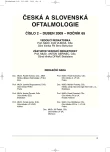Septo-optic Dysplasia – Omitted Interdisciplinary Clinic Entity: Report on Three Patients
Authors:
K. Podobová 1*; H. Urbánková 2*; S. Kriššáková 3; M. Kantorová 4; M. Šmoldas 5; M. Pura 2
Authors‘ workplace:
títo autori prispeli k práci rovnocenne
*; Očné oddelenie, Ústredná vojenská nemocnica, Ružomberok, Slovensko, vedúci prim. MUDr. Ján Čuvala, Ph. D.
1; Endokrinologické oddelenie, Národný endokrinologický a diabetologický ústav, Ľubochňa, Slovensko, vedúci prim. MUDr. Peter Vaňuga, Ph. D.
2; Pracovisko magnetickej rezonancie, Medicínske centrum NovaMed, Banská Bystrica, Slovensko, vedúci prim. MUDr. Ľubomír Miština, CSc.
3; Laboratórium evokovaných potenciálov, Neurologická klinika MFN a JLF UK, Martin, Slovensko, prednosta doc. MUDr. Egon Kurča, Ph. D.
4; Detské oddelenie, Národný endokrinologický a diabetologický ústav, Ľubochňa, Slovensko, vedúci prim. MUDr. Eva Mendelová
5
Published in:
Čes. a slov. Oftal., 65, 2009, No. 2, p. 59-63
Overview
On example of three patients with septo-optic dysplasia the authors present a rare clinical entity involving combined disturbances of endocrine and neurologic systems and variable expressed clinical triad: 1) pituitary aplasia/dysplasia with pituitary hormones deficiency, 2) developmental disturbance of the middle-brain structures (corpus callosum and septum pellucidum), and 3) dysplastic changes of the optic nerve. The knowledge about components belonging to the competence of other specialists and awareness of consequences of untreated hypopituitarism, are imperatives for interdisciplinary cooperation of ophthalmologist, neurologist, radiologist, and endocrinologist. Moreover, they predict early initiation of the adequate and often vital therapy. Molecular-genetic studies in patients with septo-optic dysplasia represent a way to better knowledge about early stages of the pituitary gland and brain development.
Key words:
septo-optic dysplasia, hypopituitarism, combined pituitary hormone deficiency, optic nerve hypoplasia, gene HESX1
Sources
1. Arslanian, S. A., Rothfus, W. E., Foley jr., T. P.: Hormonal, metabolic, and neuroradiologic abnormalities associated with septo-optic dysplasia. Acta Endocrinol. Copenh. 107, 1984; 2 : 282–288.
2. Birkebaek, N. H., Patel, L., Wright, N. B. et al.: Endocrine status in patients with optic nerve hypoplasia: relationship to midline central nervous system abnormalities and appearance of the hypothalamic-pituitary axis on magnetic resonance imaging. J. Clin. Endocrinol. Metab. 88, 2003; 11 : 5281–5286.
3. Dattani, M. T., Martinez-Barbera, J.-P., Thomas, P. Q., et al.: Mutations in the homeobox gene HESX1/Hesx1 associated with septo-optic dysplasia in human and mouse. Nature Genet. 19, 1998; 2 : 125–133.
4. Harrison, I. M., Brosnahan, D., Phelan, E. et al.: Septo-optic dysplasia with digital anomalies – a recurrent pattern syndrome. Am. J. Med. Genet. 131, 2004; 1 : 82–85.
5. Hermesz, E., Mackem, S., Mahon, K. A.: Rpx: a novel anterior-restricted homeobox gene progressively activated in the prechordal plate, anterior neural plate and Rathke‘s pouch of the mouse embryo. Development. 122, 1996; 1 : 41–52.
6. McNay, D. E. G., Turton, J. P., Kelberman, D. et al.: HESX1 mutations are an uncommon cause of septo-optic dysplasia and hypopituitarism. J. Clin. Endocrinol. Metab. 92, 2007; 2 : 691–697.
7. de Morsier, G.: Études sur les dysraphies, crČnioencéphaliques. III. Agénésie du septum palludicum avec malformation du tractus optique. La dysplasie septo-optique. Schweizer Archiv für Neurologie und Psychiatrie, Zurich, 77, 1956; 267–292.
8. Murray, P. G., Paterson, W. F., Donaldson, M. D.: Maternal age in patients with septo-optic dysplasia. J. Pediatr. Endocrinol. Metab. 18, 2005; 5 : 471–476.
9. Orrico, A., Galli, L., Zappella, M.: Septo-optic dysplasia with digital anomalies associated with maternal multidrug abuse during pregnancy. Eur. J. Neurol. 9, 2002; 6 : 679–682.
10. Pagon, R. A., Stephan, M. J.: Septo-optic dysplasia with digital anomalies. J. Pediatr. 105, 1984; 6 : 966–968.
11. Patel, L., McNally, R. J., Harrison, E. et al.: Geographical distribution of optic nerve hypoplasia and septo-optic dysplasia in Northwest England. J. Pediatr. 148, 2006; 1 : 85–88.
12. Rainbow, L. A., Rees, S. A., Shaikh, M. G. et al.: Mutation analysis of POUF-1, PROP-1 and HESX-1 show low frequency of mutations in children with sporadic forms of combined pituitary hormone deficiency and septo-optic dysplasia. Clin Endocrinol (Oxf). 62, 2005; 2 : 163–168.
13. Vosáhlo, J., Krásný, J., Srp, A. et al.: Septooptická dysplazie: morfologické, oftalmologické a endokrinní nálezy u 11 pacientů. Čes.-slov. Pediat. 5, 2003; 5 : 287–290.
14. Wales, J. K., Quarrell, O. W.: Evidence for possible Mendelian inheritance of septo-optic dysplasia. Acta Paediatr. 85, 1996; 3 : 391–392.
Labels
OphthalmologyArticle was published in
Czech and Slovak Ophthalmology

2009 Issue 2
Most read in this issue
- Central Serous Choroidopathy as Rare Complication of the Corticosteroid Treatment
- nfluence of Haemorheopheresis in the Dry Form of the Age Related Macular Degeneration
- Septo-optic Dysplasia – Omitted Interdisciplinary Clinic Entity: Report on Three Patients
- Statistical Analysis of the Nerve Fiber Layer in Color Digital Images of the Retina
